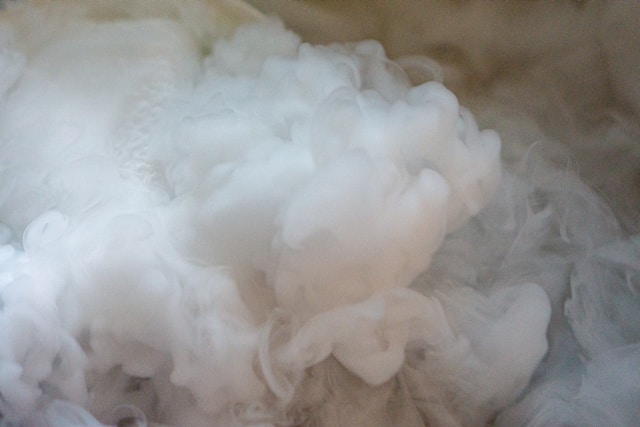

Surprising and Creative Uses for Dry Ice
Gases / Industries / Products
Dry ice is the solid form of carbon dioxide (CO2). It’s called “dry” because it doesn’t melt into a liquid like regular ice; instead, it sublimates directly from solid to gas at -109° F. Dry ice sublimination prevents water and residue from accumulating. Due to its unique properties, dry ice is used in many industries in a variety of ways. Below are common and well-known uses for dry ice.
As a cooling agent, it’s commonly used to keep food, medical supplies, and laboratory samples cold during transport. In chemical applications for laboratories, it’s used for reactions that need low temperatures. In the food industry, it’s also used to flash freeze food to maintain quality and texture (e.g., ice cream production). For cleaning, it’s used in dry ice blasting, a cleaning method that removes contaminants without water. When dry ice is placed in water, it sublimates and creates a dense fog, commonly used in theatrical productions, Halloween decorations, or special events for an eerie effect.
These are all traditional uses, but did you know that dry ice has even more surprising and creative applications?
Pest Control
Using dry ice for pest control is an innovative technique that can be effective against certain pests, particularly insects like bed bugs and termites. Many pests (including insects) require oxygen to survive. High concentrations of carbon dioxide can create an anoxic environment. This method can be very effective for pests that are in sealed areas.
Application
Place dry ice in areas infested with pests, ensuring that it is encased in appropriate containers or bags to avoid direct contact. The chosen area should be airtight or nearly airtight to maintain high CO2 concentrations. Depending on the size of the area and the severity of the infestation, this method may require repeated applications and monitoring to ensure effectiveness.
Advantages
This method is eco-friendly. Unlike chemical pesticides, dry ice does not introduce harmful substances into the environment. It can be very effective for specific pests, especially where traditional methods may not reach. It leaves no chemical residue behind, making it safer for homes, including those with children or pets.
Creating Sound Effects
Dry ice creates interesting sound effects due to the rapid sublimation process and the interaction with water or air. Artists and performers can use dry ice for special effects in live shows, combining visual elements with sound to enhance the audience’s experience. Some musicians have experimented by placing dry ice in certain instruments, where the vibrations can produce unique sound variations.
Dry Ice Sound Effects
– Rapid Release: As dry ice sublimates, it rapidly changes from solid to gas, often creating popping or cracking sounds like the noise from ice breaking or frying foods.
– Bursting Sounds: When it rapidly releases gas, it can create a loud whoosh or hiss, mimicking sounds like steam or escaping air.
– Sound Waves: When dry ice is added to water, it produces a bubbling and fizzing sound as it rapidly creates carbon dioxide gas bubbles. The intensity and frequency of sounds can vary depending on how much dry ice is used and how quickly it sublimates.
– Cavitation: The rapid boiling of water (caused by the extreme cold of the dry ice) can lead to cavitation, producing a distinctive popping sound.
– Containers: Placing dry ice in a resonant chamber (like a large jug or bowl) can amplify sounds, creating a deeper, echoing effect. This can be used in theatrical sound design for dramatic effects, such as thunder or explosions.
Preserving Biological Samples
Scientists often use dry ice to keep biological samples frozen for transport or storage, which maintains their integrity. When biological samples are exposed to dry ice, they quickly reach very low temperatures. This rapid cooling helps prevent the formation of ice crystals within cells, which can damage cellular structures and compromise the sample.
Applications
– Biological Research: Keeps DNA, RNA, proteins, and other sensitive biological samples stable.
– Clinical Laboratories: Preserves blood samples, tissue samples, and other specimens for diagnostic purposes.
– Research Laboratories: Maintains the integrity of research samples during experiments or before analysis.
Advantages
– Metabolism Reduction: At low temperatures, biochemical reactions and metabolic processes slow down significantly. This reduces the degradation of biological samples (like proteins, nucleic acids, and other cellular components) during storage.
– Inhibits Microbial Activity: The extreme cold conditions hinder the growth and reproduction of bacteria, fungi, and other microorganisms, helping to maintain the sterility of the samples.
– Preparation for Cryogenic Storage: Dry ice is often a step in the process of preparing samples for long-term cryogenic storage in liquid nitrogen, which preserves cellular integrity even further.
Dry ice is a valuable tool, and it can be used in a variety of ways. Using dry ice safely, for whatever the need, is essential to preventing injuries and avoiding health hazards. Always wear insulated gloves, safety goggles, and ensure you are working in areas with sufficient ventilation. If using dry ice in a professional setting, provide training and education on proper handling techniques.
Dry Ice Suppliers in the Rocky Mountain Region
In line with Rocky Mountain Air Solutions’ dedication to providing our customers with flawless dependability, we are expanding our service capabilities in 2024 to include a dry ice line that will support dry ice for commercial kitchens, catering and food storage, dry ice blasting, and many other applications using solid carbon dioxide. Contact your local branch today in any one of our five states (Colorado, Utah, Idaho, Wyoming, Nebraska) for more information. We look forward to serving you!



